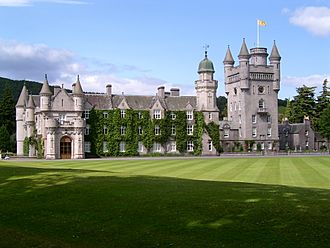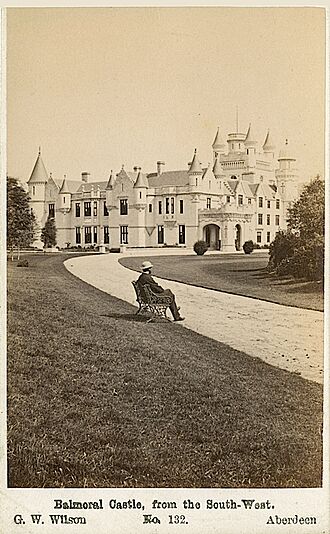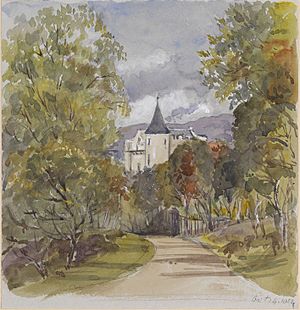Balmoral Castle facts for kids
Quick facts for kids Balmoral Castle |
|
|---|---|

Balmoral Castle from the south lawn
|
|
| General information | |
| Status | Complete |
| Type | Royal residence |
| Architectural style | Scots baronial revival |
| Location | Aberdeenshire |
| Address | Balmoral Estate Ballater AB35 5TB |
| Country | Scotland |
| Coordinates | 57°2′27″N 3°13′48″W / 57.04083°N 3.23000°W |
| Construction started | 1853 |
| Completed | 1856 |
| Owner | King Charles III |
| Height | |
| Architectural | 30.48 m (100 ft 0 in) (Great Tower) |
| Technical details | |
| Material | Granite and slate |
| Floor count | Largely two- and three-storey |
| Design and construction | |
| Architect | William Smith (City Architect of Aberdeen) |
| Developer | Queen Victoria and Prince Albert |
| Other designers | John Thomas (Sculptor) |
| Main contractor | M. Stuart |
|
Listed Building – Category A
|
|
| Official name | Balmoral Castle with Parterre and Terrace Walls |
| Designated | 12 March 2010 |
| Reference no. | LB51460 |
|
Inventory of Gardens and Designed Landscapes in Scotland
|
|
| Official name | Balmoral Castle |
| Designated | 1 July 1987 |
| Reference no. | GDL00045 |
Balmoral Castle is a large estate house in Aberdeenshire, Scotland. It is a special home for the British royal family. The castle is located near the village of Crathie, about 9 miles west of Ballater. It is also about 50 miles west of Aberdeen.
The original castle and its land were bought in 1852 by Prince Albert. He was the husband of Queen Victoria. Soon, the old house was too small. So, a new Balmoral Castle was built. William Smith designed it, with ideas from Prince Albert. Balmoral is still the private property of the monarch. It is not owned by the Crown Estate. Queen Elizabeth II used Balmoral as her summer home. She passed away there on September 8, 2022.
The castle shows off the Scottish baronial architecture style. It is a very important building, listed as a category A listed building. The new castle was finished in 1856. The old one was taken down shortly after. The Balmoral Estate has grown over time. It now covers a huge area of 53,684 acres. It is a working estate with forests, farms, and wild animals.
Contents
What's in a Name?
The name Balmoral is pronounced "bal-MOR-al." It was first written as 'Bouchmorale' in 1451. Local Scottish Gaelic speakers said it as "ba-VOR-al." The first part of the name might come from the Gaelic word both, meaning "a hut." The second part is not as clear. Some think it means "big spot (of ground)." Others suggest it might be from an old Pictish word meaning "big clearing." It could also be named after a saint.
A Royal History

King Robert II of Scotland lived from 1316 to 1390. He had a hunting lodge in this area. Records show a house at Balmoral was built in 1390. Later, the Farquharson family owned the estate. They were supporters of the Jacobite cause. This means they supported the return of the Stuart kings. In 1798, James Duff, 2nd Earl Fife, bought Balmoral. He then rented out the castle. Sir Robert Gordon rented it in 1830. He made many changes to the old Balmoral Castle. These changes included adding parts in the baronial style.
How the Royals Bought Balmoral
Queen Victoria and Prince Albert first visited Scotland in 1842. They loved the country. They came back several times. In 1847, they rented Ardverikie House. It rained a lot during that trip. So, the queen's doctor suggested Deeside for its healthier weather.
Sir Robert Gordon passed away in 1847. Prince Albert then arranged to rent Balmoral in 1848. He took over the lease, furniture, and staff. He did this even before seeing the property.
The royal couple arrived on September 8, 1848. Victoria wrote in her diary that the house was "small but pretty." She felt "freedom and peace" there. The hills reminded them of Albert's home in Germany.
The house was soon too small for their needs. In 1848, John and William Smith were asked to design new buildings. They also improved the gardens and woodlands. Prince Albert even ordered a temporary iron building. It was used as a ballroom and dining room.
The royal family officially bought the estate in June 1852 for £32,000. They also bought the nearby Birkhall estate. To celebrate, they built the Purchase Cairn on a hill. This was the first of many stone piles on the estate.
Building the New Castle

Victoria and Albert's family was growing. They needed more space for staff and visitors. So, they decided to build a bigger house. In 1852, William Smith was chosen as the architect. Prince Albert helped with the designs. He was very interested in details like turrets and windows.
Construction started in mid-1853. The new castle was built about 100 yards from the old one. This allowed the family to use the old house while the new one was being built. Queen Victoria laid the foundation stone on September 28, 1853. By autumn 1855, the royal rooms were ready. The tower was still being built.
The new house was finished in 1856. The old castle was then taken down. A new bridge over the River Dee was also built. It was designed by Isambard Kingdom Brunel.
Balmoral Castle is made from granite stone from the estate. It has two main parts around courtyards. The main rooms are in the southwest part. The service areas are in the northeast. An 80-foot tall clock tower stands at the southeast. It has turrets like Castle Fraser. The castle's style helped bring back Highland culture. The royals decorated Balmoral with tartans. They also went to highland games. Queen Victoria loved Scotland. This helped make the monarchy feel more "British."
Victoria and Albert's Life at Balmoral
The royal couple quickly settled into life in the Highlands. Victoria enjoyed long walks. Albert spent many days hunting deer. In 1849, a diarist said their life at Balmoral was like that of regular wealthy people. Victoria asked artists to paint Balmoral and its staff. Many painters worked there over the years.
Prince Albert helped improve the grounds. He designed gardens and planned farm buildings. He built a model dairy in 1861. Queen Victoria finished it after he passed away. She also built monuments to him on the estate. These included a pyramid-shaped cairn and a large statue of Albert.
After Albert's death, Victoria spent more and more time at Balmoral. She stayed for up to four months a year. She displayed many items that reminded her of Albert. She also relied on her servant, John Brown. He was a local guide who became a close friend.
In 1887, Victoria Eugenie was born at Balmoral Castle. She was Queen Victoria's granddaughter. She later became the queen of Spain. In September 1896, Victoria welcomed Emperor Nicholas II of Russia and Empress Alexandra to Balmoral. Queen Victoria made her last visit to the estate in 1900. She passed away three months later.
Balmoral After Queen Victoria
After Victoria's death, the royal family kept using Balmoral. They visited every autumn. George V made big improvements in the 1910s and 1920s. These included formal gardens south of the castle.
During the Second World War, royal visits to Balmoral stopped. Some buildings were renamed due to the war. In the 1950s, Prince Philip added new gardens. In the 1980s, new staff buildings were built near the castle.
Queen Elizabeth II's Final Days
Queen Elizabeth II had been at Balmoral Castle since July 2022. She was there for her yearly summer holiday. She was also receiving medical care. On September 6, 2022, she appointed Liz Truss as the new British Prime Minister at Balmoral. This was unusual, as it usually happens at Buckingham Palace. It was done due to the Queen's health.
Queen Elizabeth II passed away at Balmoral two days later, on September 8, 2022. She was 96 years old. She was the first monarch to die at Balmoral. It was also the first time a monarch had died in Scotland since 1542. The Queen's coffin stayed in the castle's ballroom for three days. This allowed the Royal Family, staff, and neighbors to pay their respects. On September 11, the coffin was moved to Palace of Holyroodhouse in Edinburgh. This began the state funeral events.
Castle Design
Even though it's called a castle, Balmoral is mostly a country house. It is a typical Victorian-era country house. The tall tower and "pepper pot turrets" are key features. They show the Scottish baronial style. The seven-story tower is like old medieval defensive towers. The "pepper pot" turrets were inspired by French castles from the 1500s. Other features include crow-stepped gables and battlemented entrances.
Who Owns Balmoral?
Balmoral is private property. It is not owned by the Crown, like other royal homes. Prince Albert bought it privately for Queen Victoria. This means money from the estate does not go to Parliament. It stays with the monarch. When Edward VIII became king in 1936, he inherited Balmoral. But when he gave up the throne, he kept it. A deal was made for his brother, George VI, to buy Balmoral.
Queen Elizabeth II inherited the estate from her father. After her passing, ownership went to her eldest son, King Charles III. The estate is managed by a group of trustees.
The Balmoral Estate
Size and Activities
Balmoral Estate is inside the Cairngorms National Park. It is also part of the Deeside and Lochnagar National Scenic Area. The estate is about 50,000 acres. It has many different landscapes. These range from the Dee river valley to open mountains. There are seven Munros on the estate. These are Scottish hills over 3,000 feet tall. The highest is Lochnagar, at 3,789 feet. This mountain was the setting for a children's story. The Old Man of Lochnagar was first told by Charles III to his younger brothers. The story was published in 1980. Its earnings go to the Prince's Trust (now the King's Trust). The estate also includes the 7,500-acre Delnadamph Lodge estate. Queen Elizabeth II bought it in 1978.
The estate reaches Loch Muick in the southeast. There, you can find an old boat house. There is also the Royal Bothy (hunting lodge), now called Glas-allt-Shiel. Queen Victoria built it.
Balmoral is a working estate. It has areas for grouse hunting, forests, and farmland. It also manages herds of deer, Highland cattle, and ponies. Visitors can go fishing (for a fee) and hiking during certain times of the year.
About 8,000 acres of the estate are covered by trees. Nearly 3,000 acres are used for forestry. This produces almost 10,000 tonnes of wood each year. Ballochbuie Forest is one of Scotland's largest old Caledonian pine forests. It is about 3,000 acres. It is managed with very little human interference. The main mammal on the estate is the red deer. There are about 2,000 to 2,500 deer there.
The areas of Lochnagar and Ballochbuie are special protected areas for birds. These include red grouse, black grouse, ptarmigan, and capercaillie. Ballochbuie is also protected for its native Caledonian Forest. There are also four sites of special scientific interest on the estate.
The royal family employs about 50 full-time staff. They also have 50–100 part-time staff. These people help maintain the working estate.
There are about 150 buildings on the estate. These include Birkhall. This was once home to Queen Elizabeth The Queen Mother. King Charles III and Queen Camilla spent their honeymoon there in 2005. Craigowan Lodge is often used by the royal family's friends. It is also used when Balmoral Castle is being prepared for a royal visit. Six smaller buildings on the estate can be rented as holiday cottages.
Visiting Balmoral Castle
In 1931, the gardens and castle grounds were opened to the public. They are now open daily from April until the end of July. After July, royal family members arrive for their annual stay. Until 2024, the ballroom was the only room inside the castle that the public could see.
In 2024, a limited number of people could tour the castle's interior. They could see several rooms used by the royal family. This was the first time the castle was open to the public since it was finished in 1855. The gift shop, restaurant, and café were also updated. They now highlight local Scottish crafts.
Craigowan Lodge
Craigowan Lodge is a stone house with seven bedrooms. It is about 1 mile from the main castle. It is more rustic than the castle. Prince Charles and Princess Diana often used it when they visited. In May 1981, Charles and Diana took a photo at the lodge before their wedding.
Queen Elizabeth II and Prince Philip often spent the first few days of their summer holiday at Craigowan Lodge. This was because the main castle was still open to tourists.
More to Explore
- Ardverikie House, sometimes used as Balmoral Castle in movies
- Crathie Kirk
- List of British royal residences
- Castles in Scotland
- Alatskivi Castle, an Estonian castle inspired by Balmoral
- Balmoral chicken
See also
 In Spanish: Castillo de Balmoral para niños
In Spanish: Castillo de Balmoral para niños







